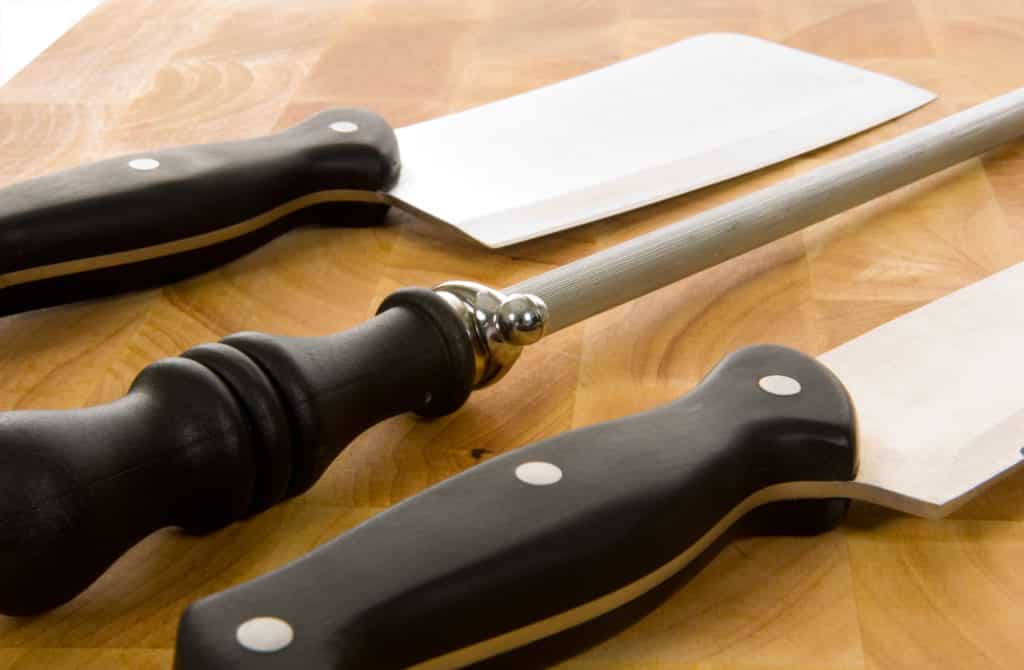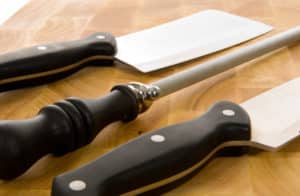
What You Need to Be a Better Chef (Knives)
- September 28, 2021

To be a better chef isn’t just about how great the presentation is on your plate. Being a better chef is what tools you use and how you use them. There is also practice, practice, practice. Anyone can just go to the store and grab a set of knives to take home with them, but what makes a knife so special and unique to the chef? Let me go into further detail about that.

You really only need 4 knives:
- chef’s knife
- heavy-duty chopping knife
- small paring knife for prepping vegetables
- serrated edge knife for carving and slicing
Before you buy a new set of knives, hold the handle in your hand first to make sure it feels right. The handle is the secret to a great knife. If you’re comfortable holding the handle, cutting will be much easier. Now let’s get into each of the 4 knives we just mentioned.
The Chef’s Knife is an all purpose knife used for chopping, slicing and mincing. It’s typically around 8-14 inches long with a curved blade. The curve to this knife is there so you can cut using a rocking motion. which makes things a lot faster and easier. The chef’s knife is made to be heavier as their weight helps with chopping and mincing.
The heavy-duty knife, or a cleaver is often used to break down tough meats. You want to make sure this heavy-duty knife can cut through just about anything, including bone. This knife isn’t used to just cut through tough meat and bones, it can also be used to crush garlic and chop vegetables.
The Paring Knife is one of the most versatile and flexible knives. It’s used to smoothly slice fruits and vegetables because of its short blade and weighted handle. Most are more comfortable with this knife, which is completely understandable. You can do a lot with the paring knife that most others you can’t quite do. For example, the paring knife can easily cut between the veins of an orange to get that perfect slice.
The Serrated Edge Knife is mainly used to perfectly cut freshly baked bread and other foods. The way it cuts is backwards and forwards in a sawing action, hence serrated edge. You can use this knife to cut breads, tomatoes, or other things that might be more difficult for any other chef’s knife.
How to Sharpen a Knife
Over time, your knives can become dull and not able to cut through a tomato as smoothly. In that case, you’ll need to sharpen your knives. The secret to keeping sharp knives is to always hone them with your steel handle before you start cooking. A honing steel will realign and a sharpener will reshape. Using a steel will realign the teeth of your knife. Properly hold the steel with a good grip and keep your thumb placed under the butt of the steel. You never want to have your thumb on the outside because the knife comes back when you are sharpening, then you’ll end up losing a finger. Place the bottom of the knife to the steel, holding it at a 15 degree angle and glide it down to the top of the blade. Cross your strokes slow over the top of the steel and then come back in towards you. Repeat this on the other side of the blade and continue the same strokes slowly. Eventually once you have done these enough times, you’ll be a lot faster. Until then, take it slow.
However, after an extended amount of use, the edge of your blade will need to be reshaped. To reshape your blade it will require using a stone. You may want to take your knife to a professional to have the edge reshaped if you don’t know how to do it yourself. Achieving the perfect angles with a stone requires a tremendous amount of practice and expertise. Most stones may be used either dry or moistened with oil or water. If you choose to wet the stone, make sure to use the same oil or water each time. Make sure the stone is secure by placing a damp cloth underneath before you get started. Hold the blade at a 20-degree angle and guide the full length of the blade across the stone with light pressure. Wipe the blade clean of any fragments before using it on a steel.
Preparing your cutting area
Place a thick, wooden cutting board on your counter or wherever your cutting area is going to be. Make sure your board is sturdy and doesn’t rock or slide. If it does, get a wet paper towel and place it underneath the board. Now you are ready to cut with confidence.
Cutting an onion
To start cutting the onion, slice it in half from one point to the other and place one of the halves face down. Point your knife towards the root, avoid cutting it completely but try to get as close to the root as possible. If you continue to cut the root, it’s going to cause all the onion’s aroma to release.
Once you have created nice long stokes, push the onion back together and push the knife half way into the onion. Slightly tilt the knife down as you are slicing and do one more stoke at the top. Grip the onion again firmly so that your slices are securely in place. Now you can cut the onion horizontally all the way through, starting from the flat end to the root. This creates a finely chopped onion without wearing any safety goggles.


